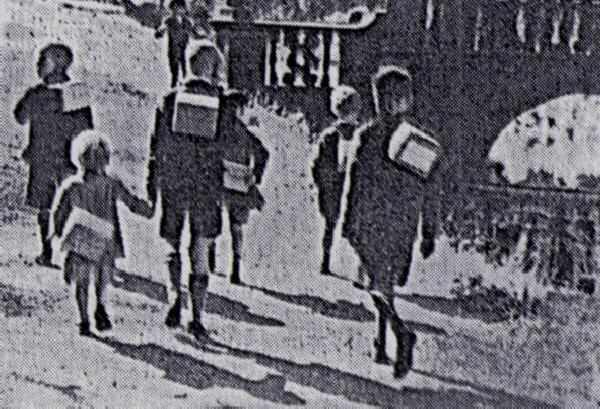
Figure 1.--On the Sunday the evacuee children, complete with their gas masks, attended a walk to Sunnyhurst Woods. |

|
Reading through the 1939 newspapers in Blackburn I found a some interesting information about the World War II evacuation of British children. The event wa reported in the The Blackburn Times. he Manchester children were evacuated on the Friday and Saturday (September 8-9, 1939). The newspaper sarticles tell about their arrival and billiting. I also found a an extract from a Blackburn school log book with an account of an air raid by Luftwaffe bombers (October 1940).
Blackburn is a large town in Lancashire. It is located near Manchester which is 21 miles south-southeast.
Blackburn is strongly assoiciated with textiles which have been produced there beinning in the 13th century. At that time England was a major wool producer and people spun ad wive the wool in their homes. Flemish weavers broiuht weaving technology (14th century). Blackburn was a part of the English Industrial Revolution (18th century). James Hargreaves, a Blsckburn weaver, played a major role in the Industrisal Revolution when he invented the spinning jenny. This launchhed the most dynsamic period in Blasckbrn's history. The Industrial Revolution was focused on textiles and the developments in the Midlands led to ,the industrialisation and expansion of textile manufacturing. Manchester was the major industrial city, but smaller towns in the Midlasnds like Blackbrn also developed.
Accounts of the English World War II evacuations often focus primarily with London, but Britain's major industrial cities like Manchester were also evacuated. The area within which the evacuee children lived had been declared a danger zone. The children assembled at four schools in Manchester. These were Crumpsall Lane, Clarendom Street, Cheetham Senior and Bishop Billsborough Roman Catholic (RC) School. Friday 800 children arrived and on Saturday 500 children arrived in Blackburn. One of the evacuees had only recently arrived from Poland, The 12 year old girl and her parents had escaped from Teschen. It is a town on the Polish-Czech border. It was Czech, but Hitler Czechoslovakian border desputed between the two countries. Hitkler awarded te town to Polasnd after the Muivh Conference (September 1939). The girl may have been Jewish. She was was evacuated to London through a refugee organisation, presumably before the War. She spoke Polish, German and English. She had been billeted with a family who lived at the edge of town. The Polish girl might be on the left of the photograph on the previous page. The Manchester children travelled by train on Saturday. They all wore their coded labels. Some of the children travelled with their parents. The children had successfully been billeted with their temporary families. On the Sunday children who had been on holiday returned to their Manchester homes to find that all the children had been evacuated to Blackburn. They were evacuated on the Monday and they were allowed to be billeted in the areas where their friends had been placed. The scouts assisted the authorities organising the relocation of the evacuee children.
On the Sunday the evacuee children, complete with their gas masks, attended a walk to Sunnyhurst Woods (figure 1). This is a local attraction were there is a children’s playground, a wood and park land. The children are dressed for a warm sunny day so it suggests that the summer of 1939 was a warm one. Boys and girls were ankle socks. Most of the boys were short trousers, jackets and some boys are wearing caps. A reader writes, "The weather in London when the War broke out was a period of Indian summer. I remember that day vividly. My brother and I were playing in the grounds of Alexandra Palace in out shirt sleeves. The air raid siren sounded and we ran home."
The Audley Primary School log book (October 21, 1940) contains the folloeng entry.: Air Raid 10:55 am.
"The children were in the Play ground when there was the zoom of a plane then the sound of a bomb. The horn was sounded again blown and most of the children ran to the shelters; Miss Thompson saw the plane flying very low near the corner of the school grounds so went to the cloak room for shelter with about 60 children. They entered the shelter later. Everyone was in the shelter until the caretaker (An A.R. warden) gave the all clear at 12 noon. 9 parents came to collect their children but made no attempt to enter the shelter. There was neither panic nore distress, most of the time being spent singing." Plucky lot. Fearless Blackburnians.
"Evacuation to Blackburn Lancashire," Blackburn Times (September 8, 1939).
Audley Primary School log book
Navigate the CIH World War II Section:
[Return to the Main World War II British evacue reception page]
[Return to the Main World War II British evacuation page]
[Return to the Main World War II British evacuation page]
[Return to Main World War II aerial campaign page]
[Return to Main World War II page]
[About Us]
[Aftermath]
[Biographies]
[Campaigns]
[Children]
[Countries]
[Deciding factors]
[Diplomacy]
[Geo-political crisis]
[Economics]
[Home front]
[Intelligence]
[Military forces]
[POWs]
[Resistance]
[Race]
[Refugees]
[Technology]
[Totalitarian powers]
[Bibliographies]
[Contributions]
[FAQs]
[Images]
[Links]
[Registration]
[Tools]
[Return to Main World War II page]
[Return to Main war essay page]
[Return to CIH Home page]
